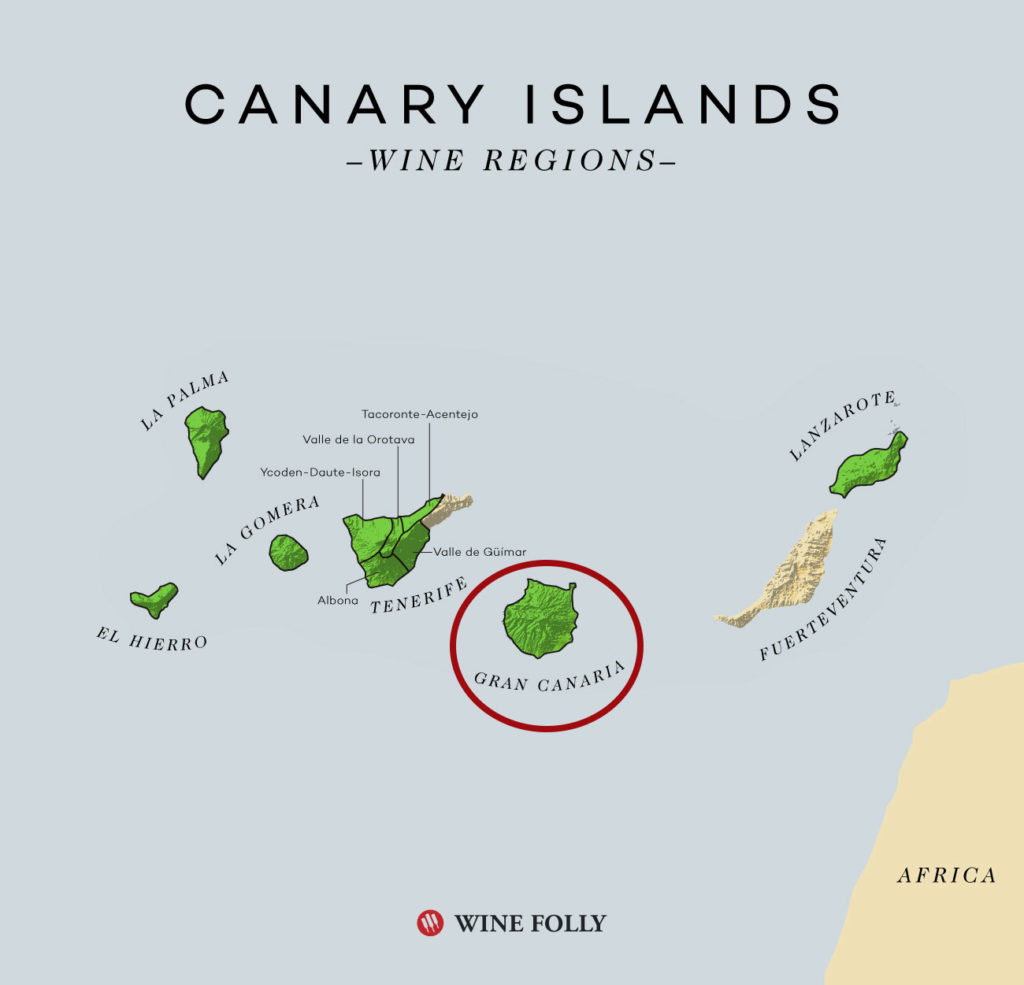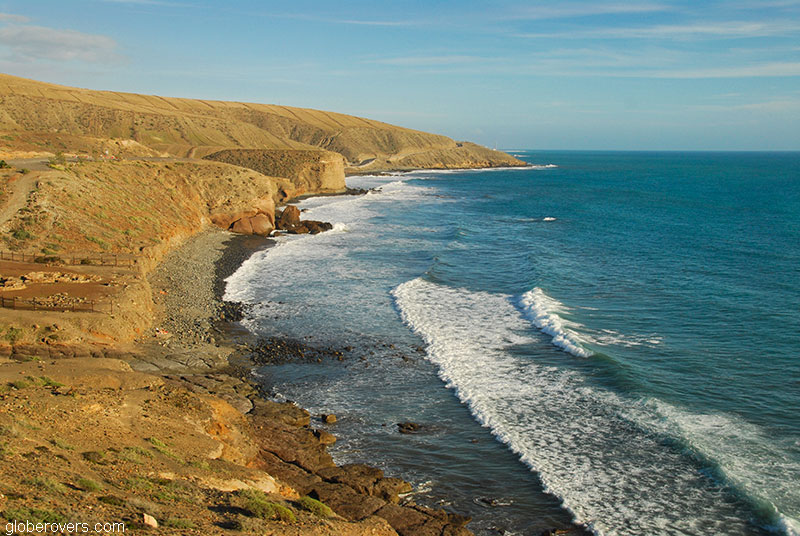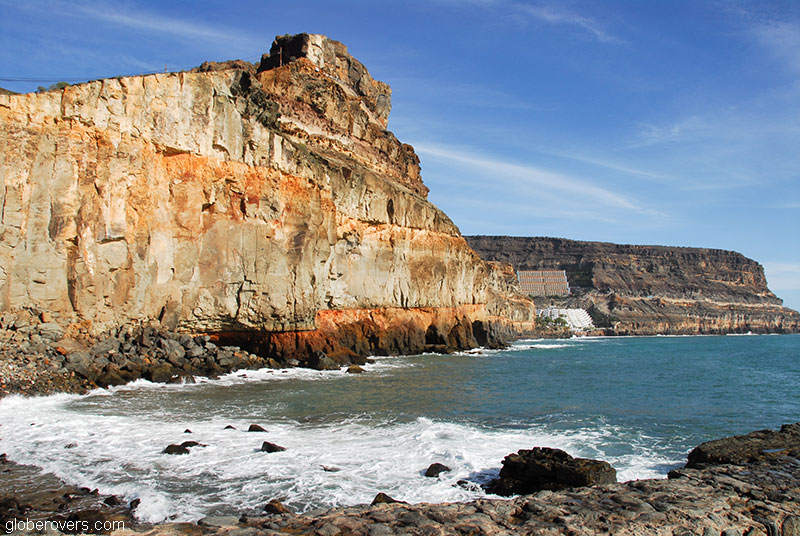
Located on an archipelago of the North Atlantic Ocean just 110 km off the west coast of Morocco, the Canary Islands (Islas Canarias) are geographically part of Africa, politically part of Spain, but notably more Spanish than African. Alas, during the high season of the European holidays, these islands are more European than Spanish.
We take a closer look at the round shape Isla Gran Canaria (Grand Canary Island), the fourth largest and second most populated of the eight islands of the Canaries (in 2018, La Graciosa “islet” of Lanzarote was finally recognised as the eighth inhabited island of the Canaries).
Why Travel to Gran Canaria of the Canary Islands?
- The low-down: The Canary Islands consist of eight main islands, each distinct in its own way – all guaranteed to offer the visitor endless excitement. Gran Canaria Island, with a diameter of approximately 50 km (31 mi), has a bit of everything!
- The brightest highlight: So much to see and do on the Canaries. One of the brightest highlights must be the beaches, in particular, those around the Maspalomas sand dunes on Grand Canaria Island.
- Intrepid destination: As the second most populated of the eight Canary islands, with hordes of European tourists, Gran Canaria is not exactly an intrepid destination. However, if you have private transport, or willing to bus and hike, you can get to quite desolate areas especially around Roque Nublo 1,813 metres (5,948 feet) and Pico de las Nieves 1,949 metres (6,394 feet). For a truly intrepid experience, head over to Lanzarote Island with its incredible landscapes and few tourists as well as La Isla Bonita, El Hierro and La Gomera.
- Globerovers score (10 is highest): I have only been to Gran Canaria which I’ll score a 7.5 – low due to it being quite developed and touristy. Once I have explored the rest of the islands, I bet the Canaries will be a much higher score.

Table of Contents
Highlights of the Canaries
- Timanfaya National Park on Lanzarote Island. The lunar landscape here was created by a volcanic eruption that covered about a third of the island in the 1700′s.
- Catamaran sailing between the islands. Strong winds, in particular around Lanzarote Island, make the seas around the islands a sailor’s dream.
- Mount Teide and Las Canadas National Park, Tenerife. Mount Teide’s 3,718 m snow-covered summit is the highest point above sea among all the islands of the Atlantic and is the third highest volcano on a volcanic ocean island in the world after Mauna Kea and Mauna Loa in Hawaii.
- Maspalomas Sand Dunes on Grand Canaria Island is stretched along a 12 km long beach.
- The Island of Lobos on Fuerteventura Island offers unrivalled tranquillity and natural beauty and opportunities to spot rare plants and birds.
- Garajonay National Park, La Gomera Island, is a well preserved Laurel forest to observe the two Canarian endemic pigeons: Laurel Pigeon and Bolle’s Pigeon.
- Quaint villages and towns such as Puerto de Mogán in the south of Gran Canaria, Las Palmas also on Gran Canaria, La Laguna and La Orotava on Tenerife. Santa Cruz town on La Palma island is a seaside town with quaint manor houses, churches and colourful balcony homes dating from the 16th and 17th centuries.
- Several beautiful beaches such as Playas de Papagayo on Lanzarote Island, Playa Del Inglés on Gran Canaria, as well as Playas de Jandía on Fuerteventura Island.
- Canary cuisine and rum. Taste a variety of tapas, Sancocho Canario salted fish, Papas Arrugadas potatoes, gofio sweetcorn and other delicacies. Try the sweet indulgence of wine made from malvasia grapes and some of the many honey rums and banana liqueurs.
The Islands of the Canaries
Most of the islands of the Canaries are quite rugged as they are of volcanic origin and mostly originate from fissure vents. Geologists reckon that much of the islands were formed during the Miocene period between 14 and 9 million years ago. This period was followed by one of erosion, which lasted some 4 million years.
From the oldest to the youngest, the islands are Lanzarote, Fuerteventura, Gran Canaria, Tenerife, La Gomera, La Palma and El Hierro. In fact, La Palma and El Hierro, the youngest of the island chain, are still above the oceanic hot spot of slow-moving, thick oceanic plates and thus still in their shield building phase.

Many more recent volcanic activities have reshaped, expanded and destroyed the islands. For example, at El Hierro island intense earthquake activity since July 2011 resulted in a new submarine eruption which started on October 2011 at a vent just off the southern tip of the island.
The larger and more popular islands such as Tenerife, Gran Canaria, Fuerteventura, and Lanzarote are best avoided during the peak holidays such as August, December, and January when the European vacationers invade them.
Sun, Sea, Beaches, Sand Dunes, and Spanish Culture
The islands of Tenerife and Gran Canaria are the liveliest tourist resort areas while the remaining islands are markedly quiet.
With a sub-tropical climate regulated by the Gulf Stream and the Trade Winds, the weather is all-year good and it is no wonder that the Canaries are referred to as “The Land of Eternal Spring”. Temperatures are very moderate and rarely fall below 18°C in the winter or rise above 25°C in summer.
The islands are all very unique in their own way and may have different appeals to different people. The most visible landmark on the island of Tenerife is Mount Teide (3,718 m) which is the third-highest volcano in the world (after Mauna Loa and Mauna Kea in Hawaii).

Lanzarote Island offers some of the most extraordinary volcanic landscapes on the planet with fields of petrified lava and beaches of black volcanic sand.
Fuerteventura Island has the longest beaches in the archipelago and is a great place to explore the rugged nature.
La Palma Island (San Miguel de La Palma) is the most volcanically active of the Canary Islands and offers the impressive Taburiente crater and fewer tourists.
Las Palmas of Gran Canaria Island
Gran Canaria Island is fairly large (1,560 square km) and is the second most populous of the Canary Islands. While it can get quite crowded with tourists during the high and peak seasons, the island is big and there are many places to avoid the tourists, who tend to mainly congregate around the beach areas of the “tourist towns”.
Founded in 1478, the main city on Gran Canaria is Palmas de Gran Canaria (or just Las Palmas) and is located in the northeast of the island.

Many tourists don’t care to visit the city as they head straight from the airport to the southern beaches. However, the city is certainly worth a few days if you are interested in the local culture and history rather than just the sun, sea, and tourist activities in the south.
Las Palmas has a very local flavour and if you speak Spanish, you will easily make friends with the locals as you sit on the boardwalk watching the sunset over the Atlantic. The city is blessed with many colonial buildings and colourful neighbourhoods abound. Many restaurants serve up Spanish and other dishes. Indulge in the tapas such as Salpicon de mariscos, Carne con papas, and Ropa Vieja while sipping on some of the popular Spanish beers such as Dorado, Tropical and San Miguel.



Exotics drinks of the Gran Canaria
The islands’ centuries-old wine industry has enjoyed unprecedented attention in the past few years. At a latitude of roughly 28°N the Canary Islands is the most tropical of Europe’s wine regions.

The Canary Islands have 10 official wine regions, five of which are on Tenerife.
The Canary Islands have been known for the famed sweet Malmsey wine, made from the Malvasia grape which is also grown in California’s Central Coast, the Balkans, Croatia, Slovenia, Portugal, Italy and Spain.
Malmsey wine is very popular with the English, Dutch and Germans, but today a wide range of indigenous grapes is grown. International varieties such as Malmsey are largely absent, yet not extinct.

While the local wines are good, the most popular drink in Gran Canaria is the rum from the town of Arucas. Arucas is a district to the east of Las Palmas and offers important agricultural, architectural and urban assets to the Canaries.
In addition, the Arehucas Rum Distillery was established here in 1884 by Alfonso Gourié as the “Sugar Factory San Pedro” and has since then made the most popular rum in this part of the world.
Reputedly being the oldest rum factory and cellar in Europe, it distributes about 80% of its annual production of 4 million litres across the Canary Islands.
In addition to its popular drink, Arehucas Rum, the Arehucas Rum Distillery also makes a wide range of spirits including rum honey and banana cream liqueurs such as Crème de Banana and Côctel de Plátano Banadrink.

located at Calle Era de San Pedro 2, Las Palmas, Gran Canaria Island
Among the best rums are Carta Oro, Carta Blanca, the 7-year old oak barrel matured Arehucas, 12-year old Reserva Espcial, Ron Carmelo and the Ron Miel Guanche honey rum. At the top is the 30-year-old oak matured Captain Kidd Rum which sells at over US$200 per bottle.
Beaches and more of Gran Canaria
After a few days of soaking up the culture in Las Palmas, take a bus to Maspalomas in the far south of the island.
There are many tourist hotels and homestays in the town known for its vibrant nightlife, long stretches of beach, and the massive sand dunes known as Maspalomas Dunes.

For all-inclusive package tours, the accommodation stretches up along the southwestern part of the island towards the little town of Playa de Mogán.
Even if you don’t stay along this stretch of tourist havens, take a day trip by local bus from Maspalomas and hop off at whichever location attracts your fancy.
Playa Del Inglés (Englishman’s Beach) is Gran Canaria’s most famous beach. The beach is sandwiched between the resort towns of Maspalomas and San Agusti and adjacent to the town of Sonnenland. Nearby is the expansive Maspalomas Dunes.

Alternatively, take a bus or car for the 40-minute drive northwest to the picturesque fishing village of Puerto de Mogán at the furthest end of this coastal road. The little village has some local culture to be savoured.
The nearby beach, Playa de Mogán, is quite beautiful and relaxing. Sadly, the area is brimming with holiday apartment complexes and hotels, as well as big nightclubs which are open all night. However, at certain times of the day the beach is deserted and a lovely place for a long walk.



Many restaurants are located along the beach. From here you can also travel by local ferry along the coast to other towns towards Maspalomas.
Another site which will require private transportation such as a 4-wheel-vehicle is Bandama Caldera near the town of Tafira.
At a height of 570 m above sea level, the caldera is for the more adventurous and if fit enough you can descend on foot. The steep walk to the bottom of the caldera takes about half an hour.
Volcanic ash of different hues is in great abundance around the caldera.
En route to the caldera stop at the small town of Teror which is right at the centre of the island and is reached via a steep winding road. The town is characterised by typical buildings, balconies and rural island life.
Enjoy the sunny Canaries!


Essential Information
Getting There
Several international airlines fly directly into the islands of Tenerife, Gran Canaria, Lanzarote, and Fuerteventura.
Getting Around
Many of the islands handle domestic flights. Ferries and charter boats also sail between some islands. The busiest islands such as Gran Canaria have a good bus network, rental cars and taxis.
When to Go
The Canaries is an all-year destination. However, the best times are between March and May and from September to November. Avoid the European holiday season, in particular December and January.
Language
The official language is Spanish (Canarian Spanish) and in the touristy areas the locals speak some English. Canarian Spanish is a close variant to Caribbean Spanish and other Latin American Spanish dialects.
Safety
The Canary Islands are known as a safe tourist destination. Note that rabies is present in bats on the Canary Islands. However, it is not found in dogs and is not a major risk to most travellers.
Tourist Visas
The Canaries constitute one of Spain’s 17 autonomous communities so the same visa regulations apply as to Spain and the EU.
☛ Read more: Azores Islands’ Secrets, Portugal


Further reading
- Azores Islands’ Secrets, Portugal
- Australia’s Lord Howe Island
- 5 unexpected reasons to visit Gran Canaria

Blog post and photos by Peter who has been travelling almost full-time since 2005 and has been to over 122 countries. He visited several countries, such as Japan, more than 20 times. Peter is Editor-in-Chief and Publisher of GlobeRovers Magazine, an independent travel magazine focused on intrepid destinations.
